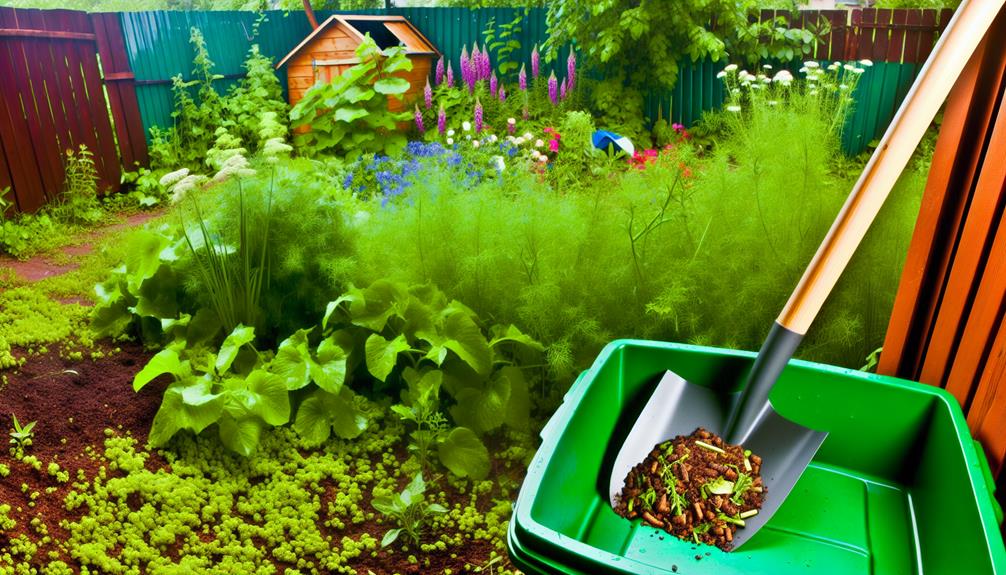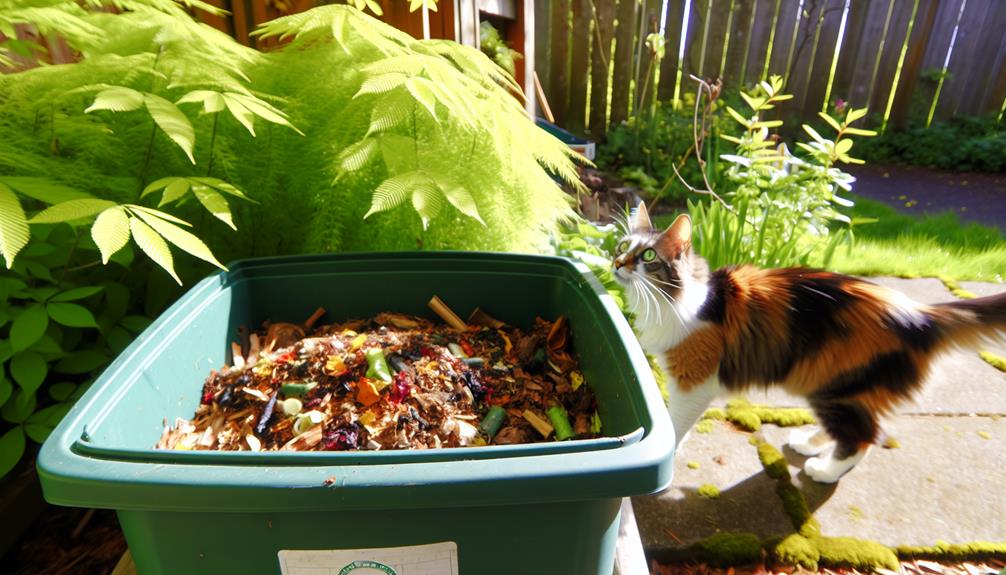

You can compost soiled cat litter, but it requires attention. Avoid clay or silica gel litters; instead, use biodegradable options like pine, corn, or paper. Always handle soiled litter with gloves and a mask due to pathogens like Toxoplasma gondii. Utilize a well-ventilated outdoor bin, far from edible plants, and mix the litter with green waste.
Regularly turn the pile and monitor its temperature to guarantee decomposition and pathogen control. Finished compost is great for ornamental plants but not for vegetable gardens. Explore further to master safe and effective composting techniques.
When you consider composting soiled cat litter, it’s important to understand the health risks involved. Cat feces can carry harmful pathogens like Toxoplasma gondii, which pose risks to both humans and other animals. Handling and composting cat litter improperly can lead to the spread of these pathogens, potentially causing serious illness. That’s why it’s vital to take necessary precautions and follow safety guidelines.
You should also be aware of the environmental impact of composting cat litter. While composting can reduce waste in landfills, not all cat litter types are environmentally friendly. Some litters contain synthetic materials that don’t break down easily and can harm the environment. Opt for biodegradable cat litter to minimize your environmental footprint when composting.
Additionally, legal regulations regarding composting cat litter vary by location. Some municipalities have strict rules about what can be composted due to health and safety concerns. Before you start composting, check with your local waste management authorities to make sure you’re complying with all regulations.
Selecting the appropriate type of cat litter is essential for effective and safe composting. Not all cat litters are created equal, and understanding the differences can greatly impact your composting efforts.
One common type is clay litter. It’s popular because it’s highly absorbent and clumps well, making it easy to clean. However, clay litter poses challenges for composting. It doesn’t break down easily and can contain chemicals that aren’t ideal for the compost pile. Additionally, mining for clay has environmental impacts, which mightn’t align with your eco-friendly goals.
Another option is silica gel litter. This type is excellent at controlling odors and has a high absorption rate. Yet, like clay litter, silica gel doesn’t decompose efficiently. It’s made from synthetic materials that aren’t suitable for composting. Silica gel litter can also be harmful to your garden if it ends up in your compost, as it doesn’t provide any nutritional value to the soil.
When considering composting soiled cat litter, it’s important to choose a type that aligns with compostable standards. Understanding these distinctions will help you make an informed decision, ensuring both your garden and the environment benefit.
Also Read: Can You Compost Cat Manure?
To successfully compost soiled cat litter, you should consider eco-friendly options like biodegradable and natural litters. These litters not only break down more easily but also offer substantial environmental benefits. Commercial options abound, so finding the right one for you and your cat should be straightforward.

When evaluating compostable litter options, look for products made from the following materials:
Using these compostable litters can significantly reduce your household waste and contribute positively to the environment. Plus, many of these commercial options are designed to be just as effective at odor control and clumping as traditional clay litters.
Make sure you take proper health and safety precautions when composting soiled cat litter to protect both yourself and the environment. First, always wear gloves when handling soiled litter to minimize direct contact. Cat waste can carry pathogens like Toxoplasma gondii, which pose serious health risks. A mask can also help prevent inhaling any dust or particles.
Next, choose an appropriate spot for your compost. Keep it away from any edible gardens to avoid contamination risks. Ensure the composting area is well-ventilated and away from water sources to prevent leaching of harmful substances into the soil and groundwater.
When adding soiled litter to your compost, mix it with other organic materials like leaves or grass clippings. This helps balance the nitrogen content and speeds up decomposition. Avoid overloading your compost with cat litter; a balanced ratio is key to effective composting.
Regularly monitor the compost temperature. High temperatures help kill harmful pathogens, making the final product safer to use. Always wash your hands thoroughly after handling the compost or soiled litter, even if you wore gloves.
Also Read: Can You Compost Blood?
When composting soiled cat litter, you can choose between vermicomposting with worms or traditional outdoor composting techniques.
Vermicomposting uses worms to break down the litter and produce rich compost, while outdoor composting involves creating a pile or using a bin in your yard.
Both methods have specific steps to follow for best results, ensuring your compost is safe and effective.
Vermicomposting with cat litter offers an eco-friendly solution to repurpose your feline’s waste into nutrient-rich compost. To get started, you’ll need to focus on worm selection and bedding choices to guarantee the process runs smoothly.
First, choose the right worms. Red wigglers (Eisenia fetida) are preferred for vermicomposting due to their efficiency in breaking down organic matter. They’re resilient, thrive in various conditions, and quickly convert waste into compost.
Next, consider the bedding. Ideal bedding choices include shredded newspaper, cardboard, and coconut coir. These materials provide a balanced environment, retaining moisture while allowing airflow.
To set up your vermicomposting system:
Diving into outdoor composting techniques, you’ll find several methods suitable for efficiently breaking down soiled cat litter. First, select an outdoor location that’s far from edible plants since cat waste can harbor harmful pathogens. A dedicated compost bin works best, especially one with good ventilation to facilitate aerobic decomposition.
Weather considerations play a significant role in composting success. In colder climates, your compost may take longer to break down, so it’s important to insulate the bin or use a compost accelerator. Conversely, in hotter climates, you’ll need to maintain moisture levels by regularly watering the compost to prevent it from drying out.
Layering is another essential technique. Start with a base layer of coarse material like straw or wood chips to promote proper aeration. Alternate layers of soiled cat litter with green waste, such as vegetable scraps or grass clippings, to balance nitrogen and carbon ratios. Turn the compost monthly to promote even decomposition and reduce odors.
To prepare the soiled cat litter for composting, start by removing any non-biodegradable materials such as plastic liners or clumping agents. This guarantees that only organic materials enter your compost pile. Next, gather your cleaning tools and get ready to sift through the litter, separating the waste from the reusable litter.
Using a scoop, transfer the soiled litter into a separate container. To maintain odor control, it’s important to do this regularly.
Here’s a checklist of what you’ll need:
Once you’ve gathered your tools, sift through the litter to remove any solid waste. It’s vital to do this in a well-ventilated area. If you’re concerned about odor control, consider using a natural deodorizer like baking soda to keep smells at bay.
You’re now ready to incorporate this prepped litter into your compost system, making sure you’re one step closer to a more sustainable lifestyle. Remember, every small effort counts in making our communities greener and more eco-friendly.
Also Read: Can You Compost Celery?
Once you’ve prepared the soiled cat litter, it’s important to oversee your compost pile properly to guarantee effective decomposition and avoid unpleasant odors. Start by selecting an appropriate compost pile location. Ideally, it should be in a well-drained area with partial shade, away from your home and any water sources, to prevent contamination.

Next, focus on compost pile maintenance. Regularly turn the pile to aerate it, which helps speed up the decomposition process and reduces smell. Aim to turn the compost at least once a week. Make sure to keep the pile moist but not waterlogged; it should feel like a wrung-out sponge.
Balance is key in composting. Ensure you have an appropriate mix of green materials (like kitchen scraps) and brown materials (like leaves or shredded paper) to complement the soiled cat litter. This balance helps create the ideal conditions for microorganisms to break down the waste efficiently.
Also, monitor the temperature of your compost pile. A properly managed pile will heat up, which indicates active decomposition. If the pile isn’t heating up, add more greens or turn it more frequently. Managing your compost pile properly oversees you get nutrient-rich compost while keeping your outdoor space pleasant.
After diligently managing your compost pile, you’ll eventually have nutrient-rich compost ready to benefit your garden. Using finished compost from soiled cat litter requires careful consideration, but it offers a fantastic way to recycle waste into valuable soil enrichment.
Here’s how you can make the most of your compost:
When using compost from soiled cat litter, avoid applying it to vegetable gardens or edible plants to prevent potential contamination. Stick with ornamental plants and non-edible landscaping to ensure safety.
Yes, composting cat litter can attract pests, but you can use pest deterrents to keep them away. Regular garden maintenance, like turning your compost and covering it, will help you create a pest-free, thriving garden community.
Yes, soiled cat litter can cause pH fluctuations in your compost, potentially disrupting the microbial balance. To maintain a healthy compost, monitor and adjust pH levels regularly. You’re part of a community aiming for successful composting!
You’re wondering about the decomposition time for cat litter in compost. It can take several months to a year, depending on conditions. Properly composting reduces environmental impact and makes you part of a sustainable community.
You can enrich soil and provide essential plant nutrients with composted cat litter. Acid-loving plants, like blueberries and azaleas, thrive with this nutrient boost. Embrace sustainable gardening and watch your plants flourish together!
You shouldn’t compost cat litter if your cat’s been on medication. Medication residue can harm the compost and increase the environmental impact. It’s important to guarantee the safety of your garden and the community.
Incorporating soiled cat litter into your compost can be safe and eco-friendly if done correctly. Choose compostable litter and follow health and safety precautions.
Prepare the litter properly and manage your compost pile to guarantee it breaks down effectively.
When using the finished compost, avoid applying it to edible plants to prevent any health risks.
By adhering to these guidelines, you’ll contribute to a more sustainable environment while managing your cat’s waste responsibly.
